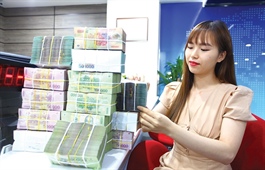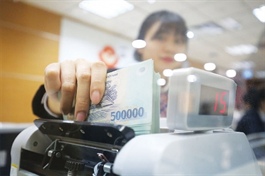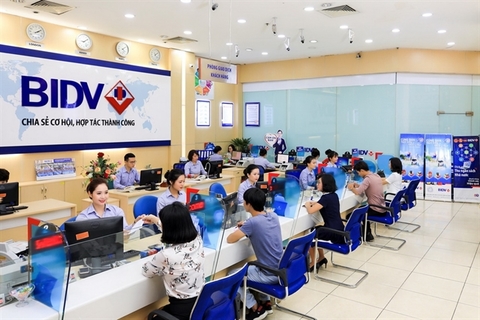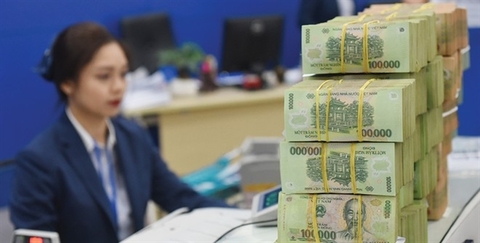Banks prepare to cushion slight rise in NPLs
Banks prepare to cushion slight rise in NPLs
Concerns are mounting about the resilience of the Vietnamese banking system amidst the COVID-19 outbreak as escalating soured debt and lower after-tax profits have put lenders in riskier positions.

Illustrative image (Photo: internet)
|
The State Bank of Vietnam (SBV) estimated affected loans at the end of the first quarter accounted for 23 per cent of total outstanding loans and are very likely to be expanded. Experts estimated that the non-performing loans (NPL) ratio will increase by 1-2 per cent, leading to higher asset quality risk and higher credit cost. As of June 19, credit growth recorded the lowest ratio in the 2016-2020 period with 2.45 per cent.
As cited from SBV statistics, by June the bad debt ratio of credit institutions was below 2 per cent; thus, the ratio of the whole year may reach the target of below 3 per cent set in the prime minister’s Decision No.1058/QD-TTg dated July 2017 on approving the scheme to restructure credit institutions in combination with NPLs resolution during 2016-2020. From 2012 to the end of this March, the entire sector handled more than VND1 quadrillion ($43.5 billion) of sour loans.
At the end of the first quarter, the after-tax profits of 18 listed banks fell 11.4 per cent compared to that of 2019, the sharpest fall since the second quarter of 2018. Data from FiinGroup, a provider of financial data and business information, revealed the NPL ratio of 16 listed banks edged up to 1.65 per cent, while six listed banks disclosed Vietnam Asset Management Company (VAMC) bonds with total outstanding debts of more than VND4.85 trillion ($210 million), down from VND6 trillion ($260 million) at the end of 2019.
This is due to Eximbank’s reduction of outstanding VAMC debts. The remaining banks are HDBank, BAC A BANK, LienVietPostBank, Vietbank, and Vietnam International Commercial Joint Stock Bank.
Specifically, as of the end of March, 79 large corporations experienced accumulated losses of more than VND100 billion ($4.34 million), including Hoang Anh Gia Lai Agrico, Petro Vietnam Construction JSC, and Vietnam Sea Transport and Chartering JSC, among others. Furthermore, the pandemic has dealt a blow to the domestic financial system, hurting lenders’ ability to generate profits.
“In the second quarter of this year, we estimate that the existing restructured loans are 8 per cent of banks’ total loans. Most banks have already rolled out relief measures to distressed customers by reducing the lending rates, thus impeding their total operating income (TOI),” Tran Thang Long, head of Research at BIDV Securities company (BSC), told VIR. “The accrued interest of these loans would not be recorded in banks’ TOI this year, which will reduce the net interest income further. We expect TOI of banks will rally around 7 per cent in 2020, and provision expense will increase by 28 per cent on-year.”
Nguyen Thi Thu Huyen, financial analyst at KB Securities, cautioned that although the majority of banks have pledged initiatives to support their customers, this stagnant state of credit growth will last until the economy can sustainably recover.
Looking on the bright side, in comparison with other Asian peers, the crisis is less severe and Vietnam now has only about 5 per cent of loans falling under moratoriums.
OCB general director Nguyen Dinh Tung held a positive outlook on business operations thanks to global relocation further unlocking Vietnam’s vast potential, thus creating more opportunities for lenders in the country as well.
Pham Quoc Thanh, general director at HDBank, meanwhile, said that only 4 per cent of outstanding loans are being affected, lower than the initial assumption of 15 per cent. Hence, the bank could still achieve upbeat performance in 2020.
Privately-held lender Techcombank also adopted a rather cautious approach to mitigate potential risks by specialising in high income customers with solid creditability, along with a reliable risk evaluation model.
“Instead of working with 10 customers, we only work with the three best ones. And instead of expanding to 10 sectors, Techcombank only participates in the two or three sectors that we understand well and so can manage the risks,” noted Techcombank chairman Ho Hung Anh.
In the case of MB, the restructured loans have kept loan growth for individual and small- and medium-sized enterprises flat so far this year, with most growth in the corporate loan book focusing on large corporates.
Long of BSC believed each bank is currently tightening credit to the risky sectors and restructuring existing loans of these sectors in bank loan portfolios. Accordingly, this would mitigate the adverse impacts of sour loans on business results.
“Banks would also reduce operating expense, and cost-to-income ratio would decrease by around 1-3 per cent. We estimate that by executing these actions, NPLs of the banking sector would slightly increase 0.4- 2.1 per cent in 2020, while provision expenses would rally 28 per cent on-year,” said Long.
Huyen of KB Securities added, “Most banks have to choose between sustainable growth by slowing down their credit to focus on better loans and high credit growth as having to expand their loan to riskier customers. Given the Vietnamese economy is going through a hard time under COVID-19 impacts, there is no perfect solution for this.”
Meanwhile, foreign bank branches in Ho Chi Minh City have recently reported low NPL ratios. In particular, the total bad loans of these branches in the area reached VND126 billion ($5.6 million) last month, which accounted for roughly 0.04 per cent of the whole banking system. International lenders might choose a different path when it comes to lending criteria, since their major customers are foreign-invested enterprises.
“In comparison with the 2009 crisis, we do believe the banking sector will have better prospects to recover thanks to a healthier banking system and suitable support from the government,” KB Securities’ Huyen told VIR.
Prime Minister Nguyen Xuan Phuc last week ordered that the economy must see a minimum rise of 10 per cent in credit growth for the whole year. The rate climbed 3.26 per cent by late June.
























